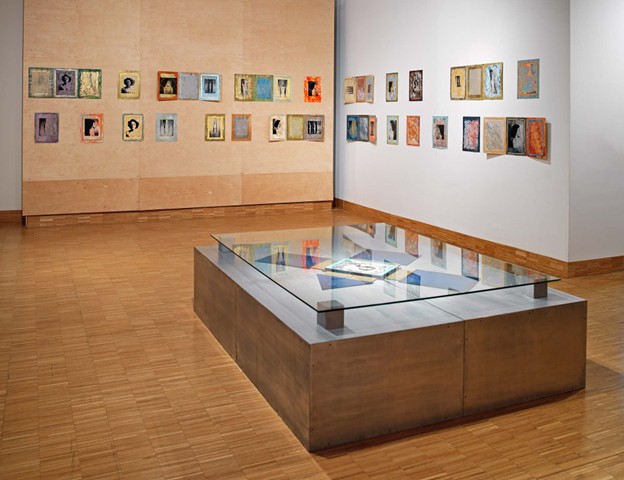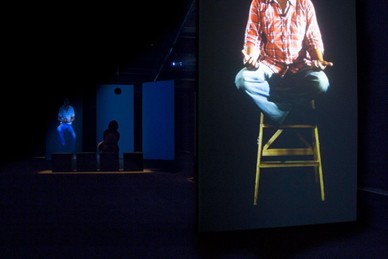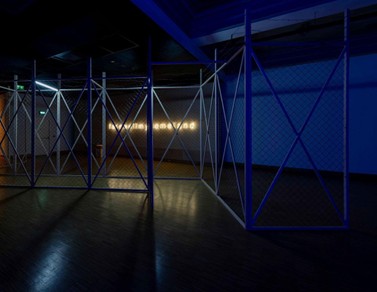
Manuscript 1994, installation view; Image courtesy of Salt / the artist.

Manuscript 1994, detail; Image courtesy of Salt / the artist.

They, multichannel video installation, 166'28'', 2015;
photograph: Mustafa Hazneci
Image courtesy of Salt / the artist.

Farewell My Homeland, 2004, Exhibition view from The Skin, Body and I, 2021–2022
Photograph: Kayhan Kaygusuz
Image courtesy of Salt / the artist.
Identity, Art and Freedom of Artistic Creativity: Manuscript 1994
Part 2
Turgut Tarhanlı, Manifold Press, June 20, 2024
Translation: Çağla Özbek
The following text is from a paper delivered by Prof. Turgut Tarhanlı at a panel discussion with Esen Karol and Çağla Özbek on the occasion of the book launch of İpek Duben: The Skin, Body and I at Salt Galata on March 26, 2024. The discussion can be accessed in two parts at the Salt YouTube channel. Part 1 is available on YouTube titled “Identity, Art and Freedom of Artistic Creativity: Şerife” dated May 16, 2024.
İpek Duben’s work titled Manuscript 1994 features a revolutionary imaginative framework where the artist’s own nude body constitutes the main axis of the work. As she elaborates on this subject, Duben says the following:
“In this journey my body was the vessel, hosting my soul in which the confrontation of the sacred and the profane, the modern and the traditional, I as ‘one’ and I as ‘part of many’ was happening and being negotiated.” 1
We know that the series of photographs, created by reproducing the portrait, profile, and nude body photographs taken in the studio of photographer Ani Çelik Arevyan in 1988, were also used in the artist’s later works. However, this use is not merely a simple act of repetition. Duben does not object to the “repetition” of the image; she describes the Manuscript 1994 exhibition in her own words as follows: “Repetition exists in this exhibition, accompanied by an acknowledgment of the constancy of repetition, alongside accepting oneself and the world. However, this is not fatalism; I do not believe in fatalism.” 2
The “repetition” seen in Duben’s works also exhibits a distinct character that is based on the traditional evolution of how the body's image has been utilized (in art). This is achieved not only by focusing on oneself and one's body as an individual, but also by taking into account a sort of cosmological plane, as demonstrated in her series titled Angels and Clowns, for instance. 3
This conscious decision of Duben does not surrender to the approach that deems it sufficient to characterise freedom of art—and therefore artistic works—merely as a form of freedom of expression. As emphasized in the press release of the exhibition The Skin, Body and I two years ago, Duben's “persistent approach to issues” seeks to go beyond this. Echoing Boris Groys’ approach, here, the important thing is to produce practices, and not objects. 4 As I have already touched upon earlier, aligning with Mouffe, 5 I consider this artistic orientation as a preference for the second phase of criticality in art and in the context of “freedom of artistic creativity”. In other words, this is not only the rejection of the conventional; it is also the realization of what constitutes the focal point of such a rejection, and the recognition of the void or the lack that is intended to be revealed.
In addition to featuring the artist’s photographs of her own body and portraits, İpek Duben's Manuscript 1994 is also an installation. Consisting of 51 images including photographs and painted works, the work is ultimately organized and nestled inside a bound, hardcover enveloping structure in the form of a box, whose lids open outwards on all four sides. In this way, the work assumes the form of a “book”, almost imaginatively.
According to Duben, “These paintings are like manuscripts. And they all come together in an album. The exhibition can very well be perceived as the explicit version of this album, this book. The book includes a text that does not feature a storyline. And in the lack of this storyline is of course, a discourse. The highlights, the repetition, and the symbolism of the image constitutes a presentation within a distinct time and space.” 6
At this point, I believe that an imaginary relationship can be forged between Duben’s Şerife series with her works titled Manuscript 1994, They and Farewell My Homeland. In addition to these, and building on Marianne Hirsch’s interpretation of the work Suspended 6 in her essay titled “Beneath the Mountains of Memory,” which is featured in the publication central to this event and excerpted below, I believe the latter work can also be included in this group.
I base my above view on the pictorial depiction of a woman in Şerife, where the body appears to inhabit a dress while paradoxically embodying an empty space in the absence of the woman; the organization of Manuscript 1994’s “storyless” texts within an enveloping structure; and the way the narrators fade into darkness following their testimonies in the video installation They.
Duben describes the work titled They using the following words:
“There is a continuous murmur of spoken words in the air and an ambient sound of singing in Turkish, Kurdish, Ladino, Armenian, Greek, and Romani in the background as each figure appears and disappears like a shining star in the void. For a moment, they are all equal.” 7
In Duben's installation Farewell My Homeland, the condition of being a refugee — a phenomenon where equality is not acknowledged, even “for a moment” — is portrayed as an almost endless state of transition, depicted through the creation of four distinct spaces. As Duben herself emphasizes in an interview featured in the book, this experience is an “endless nightmare.” 8 In the post-Cold War era, the ethnic-based internal conflicts of the 1990s are seen by Duben as indicative of a loss of Europe's 20th-century political memory, which she asserts has been profoundly shaken. Farewell My Homeland does not settle for being merely an installation; it is integrated with a book that seeks to reaffirm and record that memory.
According to Duben’s description, Farewell My Homeland sits “open on a low table in front of an armchair, inviting the viewer to sit and focus on its pages under the dim light of a single bulb. The scene is eerie; the viewer turns over the pages and can see the despair, fear, and hope in the eyes of hundreds of people as they try to cross borders on foot, in trains, and sinking boats.” 9
Judith Butler, in her commentary on Susan Sontag's book Regarding the Pain of Others 10 in the context of photography and photographs vis-à-vis framing, criticises the way in which Sontag first deems photography insufficient for proving the reality of pain and emphasizes the importance of written and oral narratives, only to then paradoxically rely on photography to substantiate her interpretation. 11 According to Butler, “After all, rather than merely referring to acts of atrocity, the photograph builds and confirms these acts for those who would name them as such.” 12
In this work, Duben includes the viewer among those qualified to name the photographs. However, her stance navigates a space between Sontag and Butler’s perspectives, without discrediting the cumulative effect of the installation as a whole and while also signifying the dark space engendered by refugeeism.
Regarding the last work, namely Suspended 6, which I previously noted that I evaluate in the same category, I defer to Marianne Hirsch, whose interpretation aligns entirely with my own:
“Here, we can sense what the body remembers, and how its memories are imprinted on the layers of skin. That body memory is visceral, haunting, incommunicable yet communicated in the work. Although we have the spine of a book in the center, it is not closed but open, and the work's surface has become a double-sided cover. An open book, seen from front and back, lacking an inside. The work of body and sense memory remains on the surface, exposed yet opaque and unreachable for the viewer.” 13
I find the concept of “space,” which remains firmly anchored within Duben's artistic framework, to be profoundly significant — both in terms of her artistic stance and its political implications. Furthermore, I believe this issue of “space” could spark a broader discussion on the notion itself, particularly as it is explored in the interview included in the book, within the context of cultural differences between the East and the West. In my view, “space” as it is signified in Duben’s work is not “nothingness”: It is not “non-existence or a state of absence”, either. However, I believe that the act of signifying both that the space occupied by “that which exists” has somehow been hollowed out and the dominant power behind such an act is deliberately echoed in Duben’s paintings. The process of “being existent” rendered invisible at the behest of certain dominant powers may be the result of either personal or societal agency. This state of order, irrespective of how it is defined — whether conceptualized as an incentive within normative frameworks or as a perpetrator within sociological discourse — constitutes a “space” whose existence, underscored either implicitly or explicitly, is inherently political. Or following Mouffe’s jargon, we could also deem it as “the populist moment”.
I mentioned above that Manuscript 1994 takes on the form of a “book” in an imaginative sense. As Duben has noted, these paintings can be categorized and arranged within their dedicated enveloping structure, akin to manuscripts. 14 But on the other hand, the fact that the book form and the act of categorization constitute a very personal field of subjectivity for the artist can also be considered as an act of documentation in the same context, and even for the same purposes. If these considerations allow us to venture into a reading of the work whereby the artist’s own life is documented within the work, which is a perspective well chronicled within the art historical tradition, we can surmise that all other types of genealogies can also be discovered departing from the work in question (which in this instance is a book). 15
Considering that the image in question is a “book,” the network of external relations it generates can expand even further, without necessarily diverging from the internal discourse of the artistic work and while remaining within its context. This network may encompass the realms of “law” and “freedoms,” as well as various genealogies, including the acts of recording, tracking, and archiving; it may also include states of being registered, unregistered, erased from records, recognized, or unrecognized by public authority. Additionally, this network involves access to news and information, practices like writing and drawing, and encompasses scriptural religions, all encapsulated through the image of the “book” within the framework of relationships established by the artwork and its external context(s).
I believe that the series/installation Manuscript 1994 possesses the evocative power of imagery that embodies a quest with significant potential for access.
The final point I would like to touch upon is in the context of aesthetics, ethics and politics. In her text titled Lecture Notes II, 16 İpek Duben defends the following perspective within the context of painting criticism in Turkey, particularly in relation to evaluations of the works of Şeker Ahmet Paşa and Hoca Ali Rıza:
“What I aim to emphasize here is that the criteria historically used to evaluate art have been predominantly rooted in moralism and fail to embody an objective, secular mentality.” 17
While it is certainly possible to analyze this perspective in the context of modernization debates in Turkey, delving into this aspect would exceed the thematic scope of this article. Therefore, the primary issue I aim to address concerns an approach where the lens of “moralism” becomes prominent, particularly in art criticism and the political codes of conduct surrounding artistic works.
This problematic, which Duben addresses in the context of the history of art in Turkey, is also a perspective defended by Chantal Mouffe in her political analysis, where Mouffe argues that critical art should operate on a two-stage axis within the aforementioned framework, and considers it erroneous to be content with mere rejection. Mouffe argues that yet another frequent misconception about critical art is “envisaging critical art in moralistic terms, seeing its role as one of moral condemnation.” 18
Indeed, it is possible to discern the influence of religious moral considerations on the Court’s judicial behavior in cases brought before the European Court of Human Rights concerning various forms of artistic expression. While this approach is not upheld too rigidly or with explicitly religious references within the framework of modern human rights and legal practice, it is not difficult at all to recognize such an influence. 19 However, we also know that the Court’s approach to the political evaluation of freedom of expression has, since the 1970s, evolved toward advocating the vigilant guardianship of a broader scope of freedom.
Mouffe’s critique of the inclination to prioritize moral values in the evaluation of artistic works aligns with Duben's observation that “a tendency to replace aesthetic values with moral values makes itself felt,” as I also quoted above. This inclination, which can be understood as stemming from a mentality disconnected from the nature of hegemonic political struggle, also seeks to frame those moral values as political values. Consequently, such approaches might even be described as “anti-political.” 20
When we reach this line of thought, I believe the trajectory of freedom in artistic expression and creativity in Turkey becomes more apparent. Notably, İpek Duben — particularly through the retrospective exhibition The Skin, Body and I, the works featured in the book of the same title we are discussing today, as well as her output in other fields — carefully navigates the political landscape through diverse, imaginary frameworks. Duben transforms, reconstructs, and re-articulates these imaginary frameworks, driven by a realistic understanding of human beings and society. Duben’s dedication to this exploration, while maintaining a persistent and principled commitment to aesthetic inquiry and an awareness of local or transnational hegemonic struggles, reflects a responsibility that she as an artist recognized she could afford to neglect.
NOTES
- Excerpt from the press release of the exhibition The Skin, Body and I organised at Salt Beyoğlu (Unpublished interview, 2021) ↩
- Lale Filoğlu, “İpek Aksüğür Duben: ‘Bu Sergi Bir Albümün Açık Hâli Olarak Algılanabilir’” (“This Exhibition Can Be Perceived as the Explicit Version of an Album”), Vizyon, p. 26. ↩
- Angels and Demons, see The Skin, Body and I, pp. 250–252 and 265–270. ↩
- Boris Groys, In the Flow (London: Verso, 2016), p. 10. ↩
- Chantal Mouffe, Agonistics: Thinking the World Politically (London: Verso, 2013). ↩
- Filoğlu, “İpek Aksüğür Duben: ‘Bu Sergi Bir Albümün Açık Hali Olarak Algılanabilir’”, 26. ↩
- The Skin, Body and I, 71. ↩
- The Skin, Body and I, 68. ↩
- The Skin, Body and I, 68. ↩
- Susan Sontag, Regarding the Pain of Others (London: Penguin, 2004). ↩
- Judith Butler, “Torture and the Ethics of Photography: Thinking with Sontag,” in Frames of War: When Is Life Grievable? (London: Verso, 2009). ↩
- Butler, Frames of War, 70. ↩
- The Skin, Body and I, 127. ↩
- The Skin, Body and I, 35. ↩
- Boris Groys, Art Power, 59. ↩
- İpek Duben, “Ders Notları II” (“Lecture Notes II”), Ipek Duben Essays and Interviews 1978–2010, Salt e-publication, 265–278. Also see EMAA Sanat Dergisi, issue 11 (March 2010): 80–105. ↩
- Duben, “Ders Notları II”, 271. ↩
- Mouffe, Agonistics: Thinking the World Politically. ↩
- e.g., Judgment of the ECtHR, Otto-Preminger-Institut v. Austria, 20 September 1994, no. 13470/87. ↩
- Mouffe, Agonistics: Thinking the World Politically. ↩